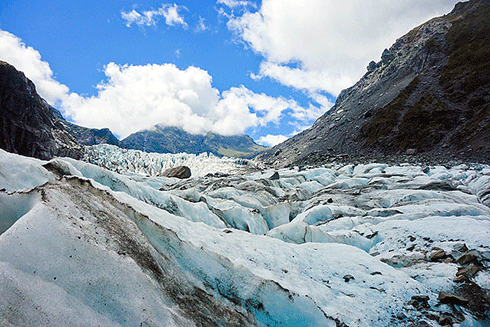
|
Published: 11 August 2014
Key drivers of climate change can be global and local
A study published in Nature Climate Change suggests that climate scientists struggling to understand a recent increase in Pacific equatorial trade winds may have been using climate models that underestimate the connection between Atlantic and Pacific ocean basins. A separate study in PNAS calls for a better understanding of regional climates, based on the findings of research into the timing of the disappearance of New Zealand’s glaciers.

|
|
Clouds in the southern Atlantic Ocean (of coast of Argentina and Uruguay) associated with a low pressure system can be seen in this image, taken in October 2011 by a NASA satellite. Rapid warming of the Atlantic Ocean drives the creation of low pressure zones close to the surface of the ocean and high pressure zones in the upper atmosphere. Credit:
NASA/NOAA GOES Project. Rob Gutro, NASA Goddard Space Flight Center. CCBY 2.0
|
The research on Pacific equatorial trade winds found rapid warming of the Atlantic Ocean, likely to be caused by global warming, has turbocharged these winds. Currently the winds are at a level never before seen on observed records, which extend back to the 1860s.
The increase in these winds has caused eastern tropical Pacific cooling, amplified the Californian drought, accelerated sea level rise three times faster than the global average in the Western Pacific and slowed the rise of global average surface temperatures since 2001.
It may even be responsible for making El Nino events less common over the past decade due to its cooling impact on ocean surface temperatures in the eastern Pacific.
‘We were surprised to find the main cause of the Pacific climate trends of the past 20 years had its origin in the Atlantic Ocean,’ says co-author Dr Shayne McGregor of the University of NSW.
‘It highlights how changes in the climate in one part of the world can have extensive impacts around the globe.’
The record-breaking increase in Pacific Equatorial trade winds over the past 20 years had, until now, baffled researchers.
Originally, this trade wind intensification was considered to be a response to Pacific decadal variability. However, the strength of the winds was much more powerful than expected due to the changes in Pacific sea surface temperature.
Another riddle was that previous research indicated that under global warming scenarios Pacific Equatorial Trade winds would slow down over the coming century.
The solution was found in the rapid warming of the Atlantic Ocean basin, which has created unexpected pressure differences between the Atlantic and Pacific. This has produced wind anomalies that have given Pacific Equatorial trade winds an additional big push.
‘The rapid warming of the Atlantic Ocean created high pressure zones in the upper atmosphere over that basin and low pressure zones close to the surface of the ocean,’ says co-author Professor Axel Timmermann of the University of Hawaii.
‘The rising air parcels, over the Atlantic eventually sink over the eastern tropical Pacific, thus creating higher surface pressure there. The enormous pressure see-saw with high pressure in the Pacific and low pressure in the Atlantic gave the Pacific trade winds an extra kick, amplifying their strength. It’s like giving a playground roundabout an extra push as it spins past.’
Many climate models appear to have underestimated the magnitude of the coupling between the two ocean basins, which may explain why they struggled to produce the recent increase in Pacific Equatorial trade wind trends.
The separate study into New Zealand glaciers provides evidence for the late survival of significant glaciers in the mountains of New Zealand at the end of the last ice age – a time when other ice areas were retreating. This contrasts with previous findings which suggested that New Zealand's glaciers disappeared at the same time as ice in the Northern Hemisphere.

|
|
Fox Glacier, New Zealand. According to a study published in Nature Climate Change, New Zealand’s glaciers began to retreat several thousand years earlier than previously thought. Credit:
Flying Kiwi Tours CC BY 2.0
|
‘We showed that when the Northern Hemisphere started to warm at the end of the last ice age, New Zealand glaciers were unaffected,’ says Prof. Shulmeister, co-author of the Nature Climate Change paper that presents the research findings.
‘These glaciers began to retreat several thousand years later, when changes in the Southern Ocean led to increased carbon dioxide emissions and warming.
‘This indicates that future climate change may impact differently in the two hemispheres and that changes in the Southern Ocean are likely to be critical for Australia and New Zealand.’
The study used exposure dating of moraines - mounds of rocks formed by glaciers - to reconstruct the rate of ice retreat in New Zealand’s Ashburton Valley after the last glacial maximum – the time when the ice sheets were at their largest.
The researchers found that the period from the last glacial maximum to the end of the ice age was longer in New Zealand than in the Northern Hemisphere.
They also found that the maximum glacier extent in New Zealand occurred several thousand years before the maximum in the Northern Hemisphere, demonstrating that growth of the northern ice sheets did not cause expansion of New Zealand glaciers.
‘New Zealand glaciers responded largely to local changes in the Southern Ocean, rather than changes in the Northern Hemisphere as was previously believed,’ says Prof. Shulmeister.
Source: UNSW and UQ

